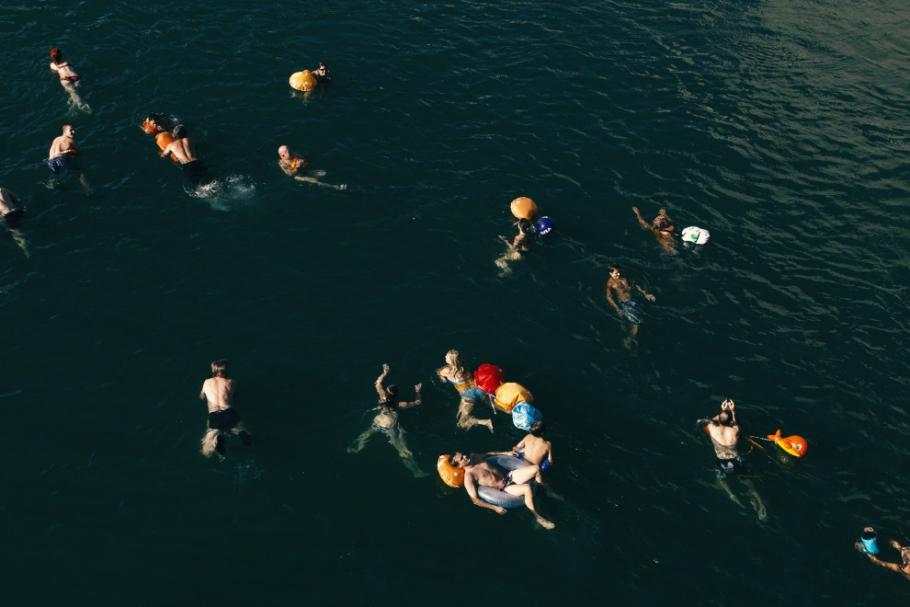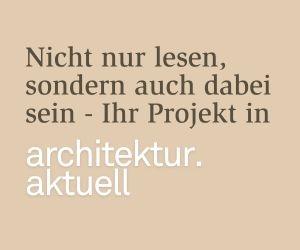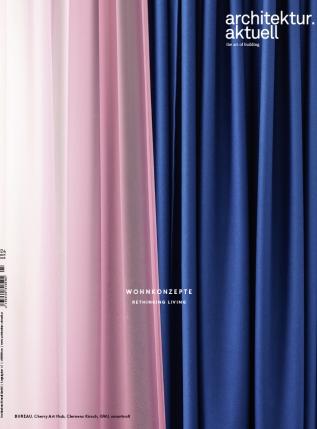Aug
Swim City | Ausstellung zum Flussschwimmen im urbanen Raum

MAO - Museum of Architecture and Design
Rusjanov trg 7
1000 Ljubljana
Slowenien
Di - So 10:00 - 18:00
Over the last few decades, Swiss cities have played a leading role in the development of this mass phenomenon by gradually opening up the river as a natural public space within the built environment. The river has thereby become a place of leisure open to all and located right outside of residents’ doors. The rest of the world looks on in awe at this bathing culture, seeing in it an example for how to successfully reclaim urban waterways for people and improve the quality of life in cities.
Swim City is an exhibition of S AM Swiss Architecture Museum, curated by Barbara Buser, Andreas Ruby and Yuma Shinohara. On view for the first time in 2019, it draws attention to a particular contemporary phenomenon in urban space: river swimming as a mass movement. The international part of the exhibition was realized in cooperation with Future Architecture Platform, an association of European architectural institutions promoting innovative positions in architecture and urban development.
Opening of the exhibition: Tuesday September 1 at 18.00
The exhibition wil be officially open by H.E. Denis Knobel, Ambassador of Switzerland to the Republic of Slovenia.
The opening will be accompanied by Round Table on swimming in Slovene rivers.
The river as public space
With this exhibition MAO wants to demonstrate the importance of public space. The exhibition renders the experience of river swimming tangible, sheds light on its historical development and current manifestation, and also explains its relevance for creating cities worth living in. This is because the public space of a city is ultimately just as important to people’s well-being as the buildings are. Swimming in the river allows one to actively occupy this urban space and experience the city differently: for once, it is the city, and not the water, that drifts by before one’s eyes. In today’s Switzerland, it is easy to take river swimming for granted. However, the fact that it is possible to use urban rivers in this way now is in fact the result of deliberate interventions, both on the political (e.g. the Switzerland-wide ban on phosphates in cleaning agents, which has significantly improved water quality) and physical level (e.g. the construction of steps for entering and exiting the river). Is the swiss scenarion possible also for Slovenia? How far away are we from the point where city rivers would become part of are every day life; a place where we spend our free time?
The experience of river swimming in the city
What awaits the museum visitor, specifically? First of all, an immersive film installation makes it possible to experience river swimming from the perspective of a swimmer. The Zurich-based film director Jürg Egli was commissioned to conceive and realise this piece. The footage was captured using a camera raft that was specially developed for this installation, making it possible to film above and under the water at the same time. Filming took place during summer 2018 in the four Swiss cities of Basel, Bern, Zurich and Geneva.
The bathing cultures on the Rhine, Aare, Limmat and Rhone
The second part of the exhibition examines the urban bathing cultures in the Swiss cities of Basel, Bern, Zurich and Geneva, with a particular focus on the local characteristics and specific historical developments in each city. In Basel, interventions from the top down as well as the bottom up, combined with the Schweizerhalle chemical incident, have prompted river swimming in the Rhine to be re-established in such a way that a summer without Rhine swimming would be unthinkable today. In Bern, the centuries-old tradition of swimming in the Aare is experiencing an unprecedented boom in popularity, posing new challenges with regards to safety and infrastructure. In Zurich, the historical bathhouses along the Limmat form the backbone of the local river-swimming scene, providing for great atmospheric diversity. In Geneva, the bathing culture in the Rhone is grassroots and informal, while the rapid change it is currently undergoing exemplifies the challenges and potentials of the river as a contested space.
River-swimming projects all over the world
The third part of the exhibition presents international projects that are attempting to realise Swiss-style river-swimming in their local contexts. Projects in Europe (Flussbad Berlin, POOL IS COOL in Brussels, Thames Baths in London, Ilot Vert in Paris) and North America (Charles River Initiative in Boston, +POOL in New York) demonstrate how various cities are approaching the task of opening up their waterways to everyone as places for swimming and recreation. A number of these have even been directly influenced by the culture of river swimming in Switzerland. Some propose alternative visions through design interventions; others lobby for a political paradigm shift through research and direct action in public space. Common to them all is a bottom-up approach to urban design that departs from purely built solutions, instead developing a multifaceted practice at the intersection of politics, design and science. This part of the exhibition was realised in cooperation with the Future Architecture Platform (where MAO is the founder and coordination entity of the platform), an association of European architectural institutions promoting innovative positions in architecture and urban development. The S AM Swiss Architecture Museum has been a member of this association since 2016.
Fužine Copacabana
Valentin Tribušon Ovsenik's project focuses on the Ljubljana River as one of the basic building blocks of the city of Ljubljana. The city was formed by the river and not the other way around. Except in the case of the city center, the Ljubljanica practically does not exist for the city. The bank of the Ljubljanica, which could represent the most crowded part of the city with a diverse program, is today, at best, an improvised park. The Fužinska Copacabana project presents a set of possibilities that the river can offer to the inhabitants of the city through architectural interventions. In addition, it breaks the myth that the banks of the river are intended only for green areas.
Accompanying publication «Swim City» offers further depth
To accompany the exhibition, the S AM Swiss Architecture Museum is releasing the Christoph Merian Verlag publication «Swim City» (224 pages, ISBN 978-3-85616-889- 6, CHF 39). In the introduction «A Country Goes Swimming – and the World Joins In», the exhibition’s three co-curators Barbara Buser, Andreas Ruby and Yuma Shinohara look at the reasons behind the current boom in river swimming in Swiss cities, and what relevance this free form of pubic space has for discourse on architecture and urban development. This is followed by an outline of the history of swimming in Switzerland by the journalist Stéphanie Sonnette. Next, Philipp Binaghi from the Swiss Lifesaving Society (SLRG) explains the prerequisites for river swimming in his essay «Balancing Between Fun and Safety». In the section
«River Stories», the bathing cultures in the four Swiss cities Basel, Bern, Zurich and Geneva are presented through texts and images (including photographs by Lucía de Mosteyrín). Under the heading «It Flows On», the focus shifts outside of Switzerland. In an interview with Tina Saaby, Chief City Architect of Copenhagen until 2019, the development of that city’s harbour as a recreational area is explained. This is followed by profiles of six international river-swimming projects, which follow the Swiss example of opening up waterways as places for swimming and recreation: Flussbad Berlin, POOL IS COOL (Brussels), Thames Baths (London), Ilot Vert (Paris), Charles River Initiative (Boston) and +POOL (New York).
Co-curators
Barbara Buser (b. 1954, Basel) is an architect and energy specialist. In 1992, she became the first ferrywoman in Basel and has regularly operated the Münster ferry across the Rhine ever since. In 1995, she founded the building components marketplace Bauteilbörse Basel and the umbrella organisation Bauteilnetz Schweiz. Since 1998, together with Eric Honegger, she has managed the construction office baubüro mitte, now called baubüro in situ. She is co-founder and co-owner of denkstatt sàrl, a think tank that specialises in project development.
Andreas Ruby (b. 1966, Dresden) is an architectural publicist, curator, book publisher and, since May 2016, director of the S AM Swiss Architecture Museum. He studied art history at the University of Cologne. He and Ilka Ruby founded the architectural publishing company Ruby Press in 2008, with which he realised over twenty book projects as an editor and publisher, some of which have won awards. In parallel, he taught architectural theory at institutions such as Cornell University in Ithaca, New York, the University of Technology in Graz and ENSAPM in Paris.
Yuma Shinohara (b. 1991, San Francisco) is a curator and editor working in the fields of architecture and urbanism. Following positions at Storefront for Art and Architecture, Ruby Press, the Akademie der Künste Berlin and the Canadian Centre for Architecture, he is currently Assistant Curator at the S AM Swiss Architecture Museum. He has translated Bruno Taut into English, among others, and has worked for magazines such as «ARCH+» and «a+u». He graduated with a degree in comparative literature and society from Columbia University in New York.
Film
Jürg Egli (b. 1956, Zurich) is a film director and artist. In 2010, with a 360- degree film installation, he brought Switzerland’s rivers as urban habitats to the World Expo in Shanghai. His latest film, «Between Calculus and Random», with artist Beat Zoderer and musician Nik Bärtsch, premiered in 2018 at the Féstival International du Film sur l’Art (FIFA) in Montreal and was subsequently released in Swiss cinemas.
Photography
Lucía de Mosteyrín (b. 1983, Algeciras) studied visual communication and iconic research at the University of Applied Sciences and Arts Northwestern Switzerland (FHNW), after working for several years as a photographer and filmmaker. Since 2013, she has lived in Basel. She has developed various projects in different Swiss cities, either alone, or in collaboration with other artists or studios. Her photographic work has been published in various annual reports by the FHNW Academy of Art and Design, where she worked from 2015 to 2017.
The exhibition in MAO has been realized thanks to the generous support by Senft AG and Embassy of Switzerland in Slovenia.

